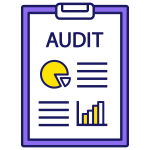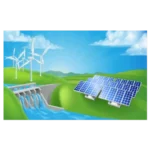Large business energy
Request bespoke 2025 large business energy quotes today
Just enter your business postcode…
Request bespoke 2025 large business energy quotes today
Just enter your business postcode…
Large businesses are presented with a broad array of options for purchasing and consuming electricity and gas. In this guide, we simplify these options to assist you in optimising your energy supplies.
If you’re searching for something specific, jump to the appropriate section below:
There’s no exact boundary between a medium and a large user of energy; however, as a rule of thumb, a large business is defined in the energy sector if it:
💡These figures are approximately ten times more than the energy consumption of the average UK home.
The complex ways larger businesses utilise electricity and gas present many opportunities to minimise unnecessary energy consumption. Our business energy experts have summarised our top six tips for optimising energy usage for large businesses.

Commercial voltage optimisation employs a piece of electrical equipment to regulate the supply of electricity to appliances, plant and equipment to optimise the supplied voltage. Operating all appliances and equipment at optimum voltage eliminates unnecessary power consumption, directly lowering the energy consumption.

An external business energy audit enables a deeper understanding of energy usage at large businesses. A business energy audit will help you pinpoint issues with energy usage, giving you a list of specific recommendations to improve energy efficiency. In some regions, the cost of a business energy audit can be offset by a business energy grant.

Large modern offices are equipped with sophisticated temperature controls, enabling workspaces to be cooled in the summer via air conditioning and warmed in the winter using a boiler. Adjusting the temperature settings to restrict heating and cooling to only what is necessary for employee comfort significantly decreases energy consumption.

Education, though frequently overlooked, is one of the most effective ways of reducing needless energy use. Encouraging energy-saving habits like turning off lights or powering down computers will save large businesses a lot of electricity over the long term. In large offices, simple systems like lighting can count as much as 40% of overall electricity consumption.

The energy efficiency of business equipment and appliances is continuously improving as the global effort towards carbon neutrality progresses. The following energy-saving devices are cost-effective and will promptly decrease business energy usage: LED lighting, lighting sensors, smart thermostats, and automatic radiator bleeders and heat pumps.

Inadequate insulation in commercial buildings forces heating systems to exert more effort to maintain a comfortable ambient temperature, leading to wasted energy. Enhancing loft and cavity wall insulation, or upgrading older windows to double glazing represents a cost-effective method to significantly decrease business gas rates.
Large commercial properties, such as factories, consume substantial amounts of electricity, yet their demand for electricity is not consistent. Peak demand occurs when they operate at full capacity, significantly reducing during other times.
The regional electricity networks must manage these fluctuations in demand to ensure there is always a sufficient availability of power for domestic and commercial properties on the network.
To handle these variations, the local grid assigns large business electricity connections with an agreed maximum power consumption for any given half-hour period.
Should your large business require additional power capacity, you will need to negotiate with your local distribution network operator and pay increased maximum demand charges.
For more information, check out our guide to maximum demand charges.
P272 is a regulation enforced on 5 November 2015 requiring large businesses to have their energy usage recorded every half an hour to support demand management across the national grid.
Sites affected by P272 were switched from NHH metres (non-half-hourly) to HH (half-hourly meters). The reason for the change was so suppliers could bill more accurately.
P272 applies to businesses in profile classes 5-8, that is MPANs starting with 05, 06, 07 or 08.
Half hourly meters (also known as HH or 00) are electricity meters that send consumption data to your business energy supplier every 30 minutes. This allows the supplier to bill you accurately for what you’ve consumed and measure maximum and excess demand charges.
Older AMR (Advanced meters) also allow half-hourly metering and standard smart meters. If you have a demand of over 100kWh, you must implement half-hourly metering reading as a compulsory measure under P272.
To tell whether or not your business has a half-hourly meter installed, you can check if your MPAN (21-digit number) begins with a “00”.
You can find this on any electricity statement in a box marked ‘S.’ Half-hourly meters are sometimes called ’00 meters’ for this reason.
An excess charge occurs when a large business exceeds the agreed power capacity in a single half-hour period.
If you notice that your business is regularly paying excess demand charges, we recommend arranging for additional grid capacity. Consultancies like Team Energy offer electricity capacity reviews and adjustments.
Government publications show companies that use large quantities of energy typically benefit from the lowest business electricity prices and gas rates due to their substantial purchasing power.
In contrast to small business energy, large companies are presented with a variety of additional choices for procuring electricity and gas supplies.
We outline these options below:

Many large businesses opt for the simplicity of fixed business energy tariffs to pay for their electricity and gas. Due to the large size of these energy contracts, business energy suppliers do not have standardised pricing.
Instead, these suppliers will offer bespoke business electricity and commercial gas rates. This complexity makes comparing business energy prices a little slower, but our energy experts are here to help with the process.
Simply enter your details above, and our business energy broker experts will be in touch to get the information needed to collect a range of bespoke business energy quotes for your company.

Business energy suppliers offer a variety of business energy contract options to large business energy consumers that are not available to the typical small business. These include:
In summary, if your large business employs an energy procurement professional, suppliers will be able to provide you with all the tools needed to execute your own energy procurement strategies.

Multi-site energy meters (or multi-location meters) are a simple way for a large multiple-property business to organise their purchases of electricity and gas. Confusingly, it doesn’t refer to a physical business energy meter.
Instead, a multi-site meter is a portfolio approach to a business energy tariff where a supplier will encompass a long list of properties (and their MPANs and MPRNs) in a single business energy contract.
A multi-site energy meter is ideal for businesses with properties with similar energy requirements, like a chain of hotels. Check out our guide to multi-site energy meters.

Large businesses have access to the capital and other resources needed to invest in generating their own renewable electricity. Options for renewable energy generation include:
Depending on the generation capacity of your investment, large businesses can export generated electricity back to the local electricity grid under the Smart Export Guarantee scheme.
Our business energy experts answer commonly asked questions regarding energy supplies to large businesses.
Yes, large businesses pay the Climate Change Levy (“CCL”) on their business energy bills. The CCL is an imposed tax on gas and electricity usage to promote reducing energy emissions. The CCL is chargeable on top of each kWh of electricity or gas used.
Companies that pay the standard rate of VAT on business energy bills at 20% are also charged the CCL. The CCL applies to companies using more than:
The Climate Change Levy is designed such that all businesses except those only consuming small amounts of energy will contribute.
According to the Office of National Statistics, here are the ten most energy-intensive industries in the UK:
Adapted from ONS Business energy spending report, grouping similar commercial activities.